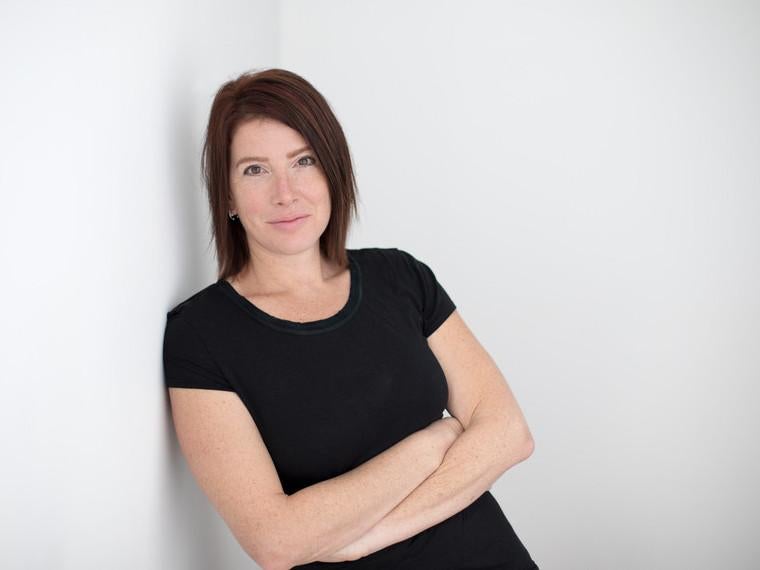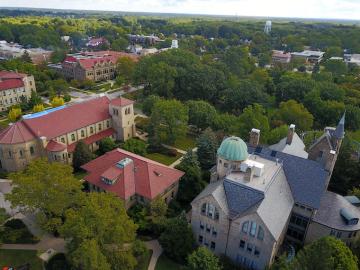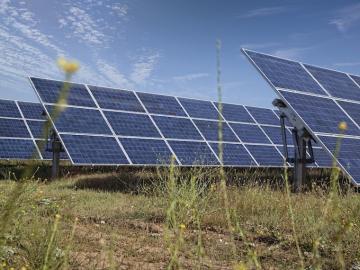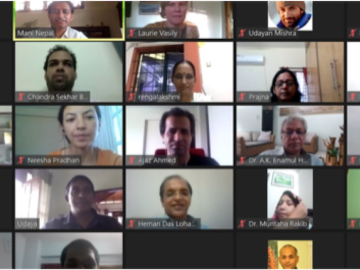Examining the Connection Between Climate Change and Environmental Justice
April 28, 2021
Office of Communications

In her recently published book Climate Change, Literature, and Environmental Justice (Cambridge University Press), Associate Professor of Environmental Studies and Comparative American Studies Jay Fiskio places climate change within the long histories of enslavement, settler colonialism, and resistance, and examines the connections between climate disruption and and a system of imperialism and capitalism.
Your book explores a range of topics including climate change, reparations, dissent, fiction, dance, and food justice. What connects these themes?
When I started to think about and teach about climate change, I took an environmental justice approach to that topic. As I was teaching about these things and thinking about them since I arrived at Oberlin, I became interested in the ways frontline communities practice dissent—how they use direct action, nonviolent civil disobedience, and other ways to protest environmental injustice. I was also interested in how these communities create different worlds. Inhabiting different worlds can take many forms, including kitchens at a blockade, or the way second lines and round dances transform public space.
Why is it essential for environmental studies activists and academics to learn about histories of enslavement?
This is something I’ve really been thinking about since I began collaborating with the community of Africatown, Alabama, in 2014. Africatown is the site where the last ship of enslaved people landed in the US, in 1860. The survivors of the Middle Passage founded Africatown after the Civil War. It’s a historic Black town and also an environmental justice community. Environmental justice (EJ) scholars for a long time have said that there is a direct link between enslavement, plantations, and environmental racism. You can see this all through the Gulf Coast and the South. Cancer Alley in Louisiana is an area alongside the Mississippi River where plantations have been converted into petrochemical factories, which pollute historic Black communities that are interspersed among these former plantation sites.That was something I learned about from walking around Africatown and seeing what this landscape looked like, and that’s where I started thinking about EJ in the context of reparations, which is that this history of environmental racism, and the ways that landscapes are structured by enslavement, goes back way before the first Earth Day. It needs to be part of our whole national conversation about race and racism, and anti-Black violence in America. That’s why I start out the book talking about the Equal Justice Initiative’s National Memorial for Peace and Justice, which is a memorial to victims of lynching, because these forms of anti-Black racism are connected through their roots in enslavement.
What can be learned about climate disruption by understanding the history of settler colonialism?
My thinking around this has been deeply influenced by the work of Potowatomi scholar Kyle Powys Whyte. He says that this idea of climate change being an apocalypse is really a settler colonial point of view—because Indigenous people in North America have already suffered multiple apocalypses—colonization, germ warfare, war, genocide, relocation. A central issue for me was to think about climate change in a much longer historical timeline, not just since when we knew climate change was happening, in maybe the 1980s or so, but trying to think about climate change as just the most recent in a series of effects of settler colonialism. That is, climate change isn’t just caused by technologies or the use of fossil fuels, it’s caused by an entire system, an entire culture, by imperialism and capitalism, by the ways that settler colonialism and enslavement are intertwined in creating the world we live in today. One of those impacts is the effect of climate change, but the roots causes are structural and based in white supremacy.
Mourning is a central theme in your book. Why is it important to think about mourning in the context of climate change?
I was really glad to have the chance to think about mourning in this book, because it’s something that has stayed with me since Hurricane Katrina. Climate change activism is often focused on solutions, and environmental studies in general is thought of as a problem-solving discipline, and so people often think of climate change in terms of technology or policy. And there’s nothing wrong with that, but the thing that interests me is that mourning is not about solving a problem, it’s about refusing to forget. It’s about remembering and honoring the dead, and it’s a kind of resistance. It reminds me of the way people talk about victims of police violence now, they use the phrase “say her name.” Remembering the names of the dead is resistance. Public mourning for the dead, demanding that the dead be recognized is a form of resistance. This is also part of the work of the Indigenous movement Idle No More, that demands investigation into missing and murdered Indigenous women in Canada.
Your book focuses on the work of frontline communities. What opportunities have you had to work with communities, and how does this work inform your thinking?
I have been really blessed to be able to work with different communities since I arrived atOberlin. This was always a priority for me, to find ways to engage with EJ communities. As someone who teaches EJ, I believe it is importantfor me to be engaged on the ground and not just to talk about it. One of the first community organizations I becameinvolved with was Vel’s Purple Oasis, which is an urban garden and teaching kitchen in downtown Cleveland that focuses on Black plant-based food traditions. I started working with Ms. Vel in 2010 and we’re still working together today—this semester there are two amazing Bonner scholars interning at the Oasis. Ms. Vel and I have also written grants together, we published an article together, we’ve done a conference presentation, and we also do a lot of work together with students. Another is the community of Africatown. I’ve been collaborating with Africatown since 2014. What has been really important to me in the work with Ms. Vel and also with Africatown, is to think about questions of respect and reciprocity, and about the importance of local knowledge—the fact that communities know their histories, and know what needs to change, and have visions for their futures. To me EJ work as an academic is about forming relationships with communities and supporting their work. This influenced my writing in the book about how frontline communities are where these better worlds are created, whether that’s an urban garden in Milwaukee or the Standing Rock prayer camps in 2016. This is where we get visions of how the world would be different, if we had solidarity and focused on honoring our relationships, where we see the real transformational work of social care, hospitality, and repair.
How do the themes of your book connect to your teaching and work with students at Oberlin?
There’s such a reciprocal relationship between my teaching and my research. Whenever I develop a new class, or come back to a class after not teaching it for a year, that’s where I’m thinking through the questions that really interest me, and it’s actually with my students that I can have the best conversations. I started teaching about climate change through the lenses of mourning and hospitality in my classes,and we had the most incredible conversations about grieving the losses of climate change—there are always things that happen in the classroom that I can’t predict. When I was writing this book, which was sometimes a struggle, I imagined writing for my students, because they are my most important interlocutors. I feel like my students have this genuine engagement with ideas that isn’t trapped by disciplines, so I feel free when I’m designing a syllabus to take risks because I know the students will be willing to be there with me. It’s also been students who have collaborated with me every step of the way in the Africatown project. The relationships that students form with community partners creates things I would never have been able to predict—the respect and reciprocity, and the genuine love and hospitality that community members show the students. Getting to witness that really affects the way I teach, because it gives me faith in the possibility of alliances and for academic work to contribute to communities.
The cover art for the book is a painting by Avehn Zimmer-Chu ’21, who traveled to Africatown as a research assistant with Professor Fiskio.

Please tell us a bit about yourself—your interests and passions, what you’re studying, and what your favorite activities are outside of class.
My name is Avehn or Zimmy, and I use they/them pronouns. I’m a fourth year ENVS and CAST major with a studio art minor, focusing in community care in environmental justice work. I love to draw, paint, and walk all over Oberlin, and I feel most fulfilled when I get to be involved in intentional communities like Third World Co-op and Baldwin Cottage. I’m also in OSLAM and work as an SIC staffer where I teach roleplays!
How did you and Prof. Fiskio begin working together? Have you collaborated on other projects together before this one?
I first met with Professor Fiskio before the winter term of my first year, when I was looking for environmental justice internships. That spring semester, one of my friends suggested that I take her course in the fall on local knowledge and environmental justice. I was super excited by the title and description, and had enjoyed working with Professor Fiskio over my first winter term, so I couldn’t wait to work with her further. The fall semester of my second year was the first time I was introduced to Africatown, Alabama and the work that she and her students were supporting there. I got to visit Africatown, and since then have continued to be involved in various capacities. I have learned so much from Professor Fiskio, not just academically but also the values and practices of working in community with people. I was able to participate in a project that was truly guided by community needs, humility from us as partners from a higher ed institution, and genuine care for our community partners. I was so honored when Professor Fiskio asked me to use my painting for her book cover, and I’m so excited and delighted to see her work!
Prof. Fiskio selected your painting to be the cover of her new book. Please tell us about your painting, and how it connects to Climate Change, Literature, and Environmental Justice.
This painting is based on one I did my second year as part of my work with Africatown through the Local Knowledge and EJ course. I wanted it to be bright and hopeful, but I also wanted to acknowledge how hard environmental justice communities and organizers work. They are growing in poisoned soil, and through that process they revitalize the land itself. It is not work they should have to do, but- like Professor Fiskio’s work- it is based in a genuine love for the community and the people within it. I have so much awe and respect for the community partners that I’ve been lucky enough to do work with and for, and I believe they deserve to be celebrated not only for their efforts but for their beauty as human beings- for their roots and their flowers. Professor Fiskio has taught me a lot about respect, growth, and care, and I wanted that to be reflected as much as possible in this book cover.
Tags:
You may also like…
Ambitious geothermal project to make Oberlin a national leader in clean energy
April 19, 2021
Oberlin College & Conservatory will take an important step toward carbon neutrality this summer as it launches a multi-year, campus-wide conversion to geothermal energy, positioning the institution as a national leader in clean energy.
Oberlin College Joins Leaders From Across the United States Affirming a Commitment to Global Climate Action
December 11, 2020
December 12, 2020, marks the five-year anniversary of the world coming together to sign on to the Paris Agreement for global climate action. To commemorate this moment, Oberlin College has joined more than one thousand leaders from local governments, businesses, tribal communities, and other institutions across the country as a signatory of the ‘‘America Is All In’’ joint statement.
Rumi Shammin Hosts Writeshop for Forthcoming Book on Climate Change and and Resilience in South Asia
October 27, 2020
More than 50 contributing authors were brought together to discuss their additions to the edited book Climate Change and Community Resilience: Insights from South Asia, which documents community-level initiatives from seven countries in South Asia, highlighting how communities have been dealing with climate change.


